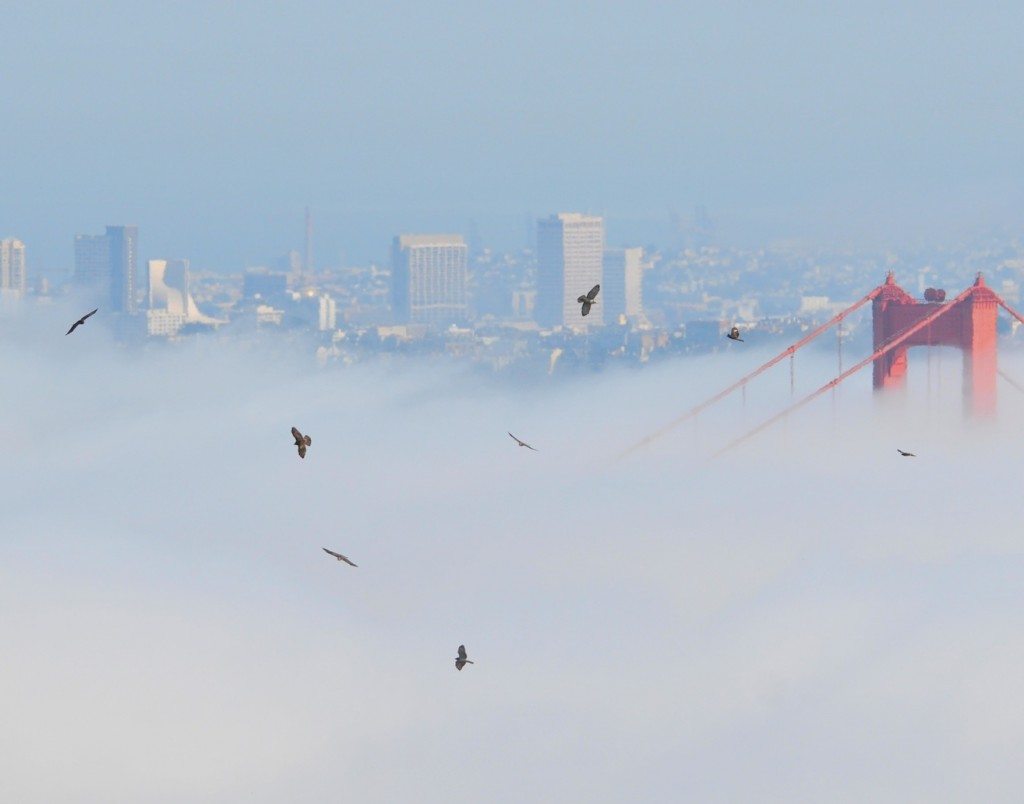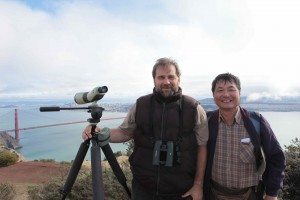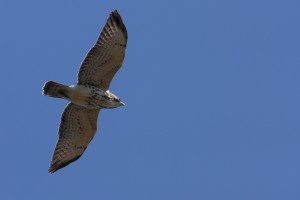Report from Hawk Hill, Part 1
Each fall, hundreds of volunteers with the Golden Gate Raptor Observatory track hawk migration through the Bay Area. From the top of Hawk Hill in the Marin Headlands, they spot and count raptors that are following the coastline south and then swerving inland when they reach the Golden Gate. GGRO’s Hawkwatch program is one of the unique treasures of Bay Area birding. To celebrate fall migration, here’s the first installment in a two-part interview with GGRO Director Allen Fish.
————————–
Q: When does hawk migration season “officially” start, peak and end??
A: Most years we start to see the early migrants – young Redtails and Osprey in particular – right around the first of August. We long ago made a decision that we would start to count and band right around August 15th and carry our daily studies through at least the first full week of December. Although, on the back end, some raptors, Redtails and even accipiters are still moving through until the first week of January. Probably because of the moderate winter climate here, some raptors have a great deal of behavioral flexibility about when they move. Some of this movement may not be classical migration, but would be more described as dispersal, that is, an ecologically-stimulated movement.
In terms of numbers of hawk-sightings, the highest flight-days of the season have fallen in a date-slot from about September 15 to October 8. However. the peak day usually hits in a smaller range of September 25-30. This peak is usually driven by Sharp-shinned and Cooper’s hawks. The big migration period — which tends to stay above 120 raptors per hour and may peak at ten times that — lasts through about November 10.

Q: About how many raptors are sighted on a typical day at the peak of the season?
A: Our peak days have ranged from about 600 sightings per day (six hours of counting per day) all the way up to 2,800 sightings per day. That was on September 21, 1984.
Q: Which species are most common?
Turkey Vultures, Red-tailed, Sharp-shinned and Cooper’s Hawks together make up 87 percent of the flight. Fifteen other species of diurnal raptors are seen most years. We’ve seen Mississippi Kite on three occasions since 1976, and a Eurasian kestrel was banded here in 2007.
Q: Where are they coming from and going to?
A: Aside from just looking at range maps, we cannot really say where the hawks are coming from, because we cannot track their movements before they arrive here and get fitted with a band or tracking device. That said, a Swainson’s Hawk from eastern Washington state with a visible ribbon attached to its tail was sighted here in 1976. Several Peregrine Falcons, previously banded elsewhere, were re-trapped here: one from the San Juan Islands, one from Crater Lake. We know from Canadian ornithologists that the only nesting region for dark morph Broad-winged Hawks seems to be Alberta, Canada. Every autumn we see at least a few of these dark morphs, so we infer that some of those hawks come from Alberta.
More than 1,000 band recoveries from birds we’ve banded here over 30 years paint a Pacific raptor flyway, which is mostly contained by the Sierra Nevada-Cascades to the east, and which runs from central coast British Columbia south to southern Baja California. Many recoveries occur along the California Coast or Inner Coast Range, and of course recoveries are hugely increased in frequency where there is a greater human population density.
By inference from range maps, we also know that some of the long-distance migrants that travel through the Marin Headlands are going much farther even though we have not tracked them. Turkey Vultures may reach the Amazon Basin. Same for the Broad-winged Hawks. Swainson’s Hawks may go either to southern Mexico or to Argentina, or perhaps places in between. Some young Pacific Northwest Osprey are known to “winter” (really summer) on the Chilean coast for up to two years before returning to their natal haunts to begin breeding. And of course arctic Peregrines can run the length of the two American continents on migration, ending up in Tierra del Fuego.
By the way, the biggest concentration of migrating raptors known on the Earth is 4 to 8 million birds per year that soar and glide past Veracruz, Mexico in September-October. This flight is mostly Broad-winged, Swainson’s hawks, and Turkey Vultures.

Q: How does weather (fog, heat etc.) affect the migration?
A: Southbound raptors seem to like a light north tailwind and a western cross-breeze as well. This gives them lift from updrafts and a scoot southward from the tailwind. Other hawks probably like the more generic thermals that allow them to gain lift and continue south or whichever direction, without having to work (flap) for it.
Q: How has this year shaped up? Is there anything notable or different?
A: As of October 31st, it’s a little early to tell, but we are just past the half-way point for the season, and the overall numbers look like a stronger flight than average.
We did have an unbelievable Broad-winged Hawk flight between September 27 and 30. After two days of white-out fog we expected a little “piling up” of Broadwings, but instead of seeing 30 sightings in a day, we had nearly 300 sightings on September 27. Near noon on September 27, there were well over 100 Broad-winged Hawks visible in the skies around Hawk Hill at one time! To put this in perspective, over the last 30 years, the greatest number of Broadwings we’d ever tallied in one season was 234 sightings, and the greatest in one day was about 30 sightings.

We just had the earliest first Rough-legged Hawk of the year, in 30 years of counting. This was on October 12, beating the most recent early Roughleg by about a week. Roughlegs are tundra-nesting buteos and they often don’t show in California ’til very late October or November.
Some species are coming through slowly this year, particularly Merlins and Northern Harriers, but we still have a lot of great days ahead. For daily counts and seasonal tabulations, check out http://www.ggro.org/events/hawkwatchToday.aspx .
————————-
Coming in Part 2: Trends in hawk migration, the Quadrant System used by GGRO in counting, tips for identifying raptors, and how to get involved as a Hawkwatch volunteer (or simply visit Hawk Hill). To learn more about Golden Gate Raptor Observatory, see www.ggro.org.
